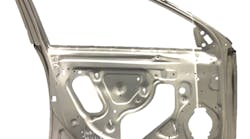Engineers from the Pacific Northwest National Laboratory (PNNL) have improved friction stir welding (FSW) so that it can now join aluminum sheets of varying thicknesses, a key capability for making welds that are strong in places where needed, yet light overall. They’ve also transformed FSW so it is 10 times faster than conventional FSW, which is limited to welding at about 20 in./min. The higher speeds mean FSW can meet the auto industry’s high-volume assembly requirements.
In FSW, a pin tool spins against the edges of two pieces of metal positioned next to each other. As the pin travels along, it creates friction that heats, mixes, and joins the alloys without melting them. To optimize the process, researchers created pins of different shape, length, and diameter, and used them in FSW but varied the depth, rotational speed, and toll angle on the pins. They then used statistical analysis to identify the most productive combination of tool and weld parameters that could support high-speed production. They also discovered that the faster FSW is carried out, the stronger the resulting welds.
In a test, the updated FSW process was used to join two sheets of aluminum, one much thicker than the other. The joined sheet was then stamped into a car door. This FSW was quicker and less expensive than conventional manufacturing methods and turned out a door that was 62% lighter and costs 25% less.
PNNL researchers are working on this project with General Motors, Alcoa, and TWB Co., with two years of funding remaining. They will use that time to get faster weld speeds and refine the process so it can be used around the contours and corners of complex aluminum parts, for which laser welding is not commercially feasible. The team also is modifying FSW to join different alloys, such as automotive-grade aluminum alloys with light, ultra-high strength alloys currently used only in aerospace applications.
In the meantime, TWB Co. has opened an FSW line at its Monroe, Mich., plant where it can manufacture up to 250,000 FSW parts per year.
